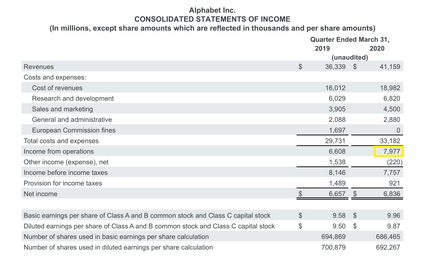NOPAT Calculator
NOPAT calculator is a tool used for evaluating the operating efficiency of a company.
Are you interested in learning more about Net Operating Profit After Tax (NOPAT)? Want to know how to calculate NOPAT or its use cases in the finance and investment world? You're in the right place. This article gives a detailed explanation of everything you need to know!
Keep reading. Or jump to the example, where we show how to calculate NOPAT with our calculator using the income statement of Google's parent company, Alphabet Inc.
What is NOPAT? NOPAT definition
The Net Operating Profit After Tax (NOPAT) is a financial measure of profitability that provides an unbiased look at the income from a company's operations if it had no debt or leverage.
Imagine you are trying to compare two companies' financial performance (HattyBags and Baggies) using their income statement. If HattyBags got a loan of $200M to boost its business operations and growth, while Baggies only got a $2M loan, this significant difference in their capital structure would make comparison difficult.
Although HattyBags may achieve more sales and, eventually, a higher net income, these values would not provide a true reflection of how well the companies' operations did.
Analyzing the companies' sales will not show how well they managed their operations. And comparing the two companies' net income would include the tax benefits the companies got from issuing debt in their capital.
NOPAT provides an accurate representation by removing the impact of their loan. That way, interest payments on the loan that shrink the company's net income are avoided.
How to calculate NOPAT
You can calculate NOPAT by multiplying a company's operating income by 1 minus the corporate tax rate.
- The corporate tax rate is also known as the effective tax rate. It is the percentage of a company's income it pays in taxes.
You can calculate the tax rate from the income statement by dividing the total tax expenses by the company's earnings before taxes.
tax rate = total tax / earnings before tax
- The operating income is also known as the operating profit. It measures the profits a company generates from its core business functions, where the deduction of interest and taxes is excluded from the calculation. Although it reveals the company's operating efficiency, it does not account for the impact of taxation on profitability.
There are two ways to calculate the Operating Income.
-
operating income = gross profit – operating expensewhere:
gross profit = total revenue – cost of goods sold
OR
operating income = net income + non-operating income loss - non-operating income gain + interest expense + tax
NOPAT formula
Because of the two operating income formulas above, there are two NOPAT formulas.
-
The simple NOPAT formula
NOPAT = operating income × (1 – tax rate)You can use this formula when a company's operating income and tax rate are expressly provided.
AND
-
The precise NOPAT formula
NOPAT = (net income + non-operating income loss - non-operating income gain + interest expense + tax) × (1 – tax rate)Depending on the available information, you can choose which formula to use. Note that for the precise NOPAT formula, when non-operating income gains or losses are made public, the non-operating income gain is deducted (-). In contrast, non-operating income loss is added (+).
The NOPAT formula does not include one-time charges or losses affecting the company's bottom line that year. This makes NOPAT an important metric in calculating the Economic Value Added (EVA) and the Free Cash Flow (FCF) of a company. We have relevant tools made. If you want to expand your knowledge horizon, then check out our economic value added and free cash flow calculator.
A company with no debt will have a NOPAT equal to its net income after tax.
NOPAT calculation examples
Example 1: When the operating income and tax rate are given
If HattyBags has an operating income of $700,000 and a corporate tax rate of 24%.
We can calculate the NOPAT using the simple NOPAT formula as follows:
NOPAT = operating income × (1 – tax rate)
= $700,000 × (1 − 0.24)
= $532,000
Example 2: When the operating income and tax rate are not expressly given
How to calculate the Net Operating Profit After Taxes for Alphabet Inc. (NASDAQ: GOOG, GOOGL).
.

-
Alphabet Inc. Operating Income in Q1 2020 is
$7,977 million. -
Calculate the Effective Tax rate for the same period:
tax rate = income taxes/income before income taxes
tax rate (Q1 2020) = $921 / $7,757 = 0.1187 = 11.87% -
Calculate the NOPAT value:
NOPAT = operating income × (1 – tax rate)
NOPAT (Q1 2020) = $7,977 million × (1 – 0.1187) = $7,030 million
Try to use the NOPAT calculator to check these values.
We also calculated the margin of safety for the recently released Google Pixel 4a using our margin of safety calculator. Check it out!
Advantages and Limitations to using NOPAT
Although NOPAT is a handy financial concept, it is insufficient to analyze a company's operating efficiency. It is equally important to assess the company's historical performance, understand the advantages, and consider the limitations of using the NOPAT formula.
Advantages of NOPAT
- NOPAT provides a more accurate representation of a company's operating profitability without blurring the details with the loan and debt payments.
- NOPAT calculation offers measurements in terms of monetary value and not percentages like other financial metrics.
Limitations to using NOPAT
- NOPAT is limited to use when comparing companies in the same industry.
- It is a profitability measure in monetary value rather than percentages, making its use difficult when comparing companies of different sizes or dissimilar business models (For example, an SME and a large corporation) within an industry.